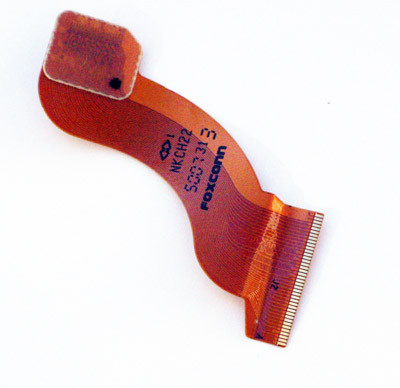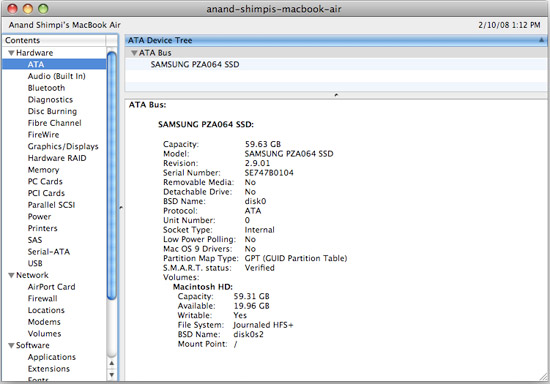The MacBook Air: Thoroughly Reviewed
by Anand Lal Shimpi on February 13, 2008 12:00 AM EST- Posted in
- Mac
The SSD Discussion
Apple inadvertently mitigated some of the dangers and annoyances of a mechanical hard disk in the Air by going with a 1.8" drive. These drives are used in the iPod and are designed to be rugged, cool and quiet. Because we're comparing an already low power, quiet drive to the SSD many of the advantages of the SSD just aren't as noticeable.
One aspect of SSD performance that isn't often talked about is that performance doesn't change as the drive gets fuller. Mechanical disk drives are designed to write to the outer most sectors first (where read speed is the fastest) and the inner most sectors last (where read speed is the slowest). When your drive is mostly empty, everything gets written to the fast part of the disk. As it gets full, data is written to the slower parts and thus you get degraded performance. The same doesn't apply to a SSD, since we're just writing to flash; performance is the same regardless of what part of the flash you're reading from.
If money were no object and we had to make a recommendation today, we'd still take the SSD over the mechanical drive. It is more responsive in the areas that bothered us the most when using the Air, it increases battery life by a good 14% on average and most importantly - it lowers the risk of a drive failure while on the road. The first stipulation of that recommendation is the one that's worth paying attention to: if money were no object.
Apple charges a hefty $999 for the 64GB SSD option, and on a $1799 notebook that's not insignificant; we're talking 55% of the price of a standard MacBook Air just for a drive swap. Apple isn't making that much profit on the drive either. The 64GB Samsung SSD Apple uses in the Air costs around $760, Apple actually makes more from the 200MHz CPU upgrade than the $999 SSD.
The beauty of solid state storage is that it's based on Flash, whose prices are directly influenced by Moore's Law. We've been told that within 3 months you can expect the cost of these 64GB SSDs to drop by around 30%, so we'd be looking at around $530 for the same drive in the near term. Obviously we're talking about cost here, if we apply the same 28% markup Apple currently uses on the SSD option to the new price we get around $680 for the SSD upgrade in 3 months. There's no guarantee that Apple will pass on the savings but if they don't, you can always shop around for the drive from another vendor such as DVNation.
Price isn't the only thing that will improve with time: performance will as well. When the transition to solid state disks first started happening the controllers (the chip that sits between the PATA/SATA interface and the Flash memory) were hardly optimized for performance. Because performance was so poor, the first SSDs were used for industrial applications where the ruggedness of the drives were most important and performance didn't really matter.
As controller technology advanced, so did performance but since the SSD market was still small the manufacturers had to pick and choose their battles. The natural fit for higher performance drives was the 2.5" SATA SSD market, after all these drives would be going into expensive notebooks. Controller development for PATA drives just wasn't as far along and thus PATA SSD offerings generally lagged behind in performance compared to their SATA counterparts.

The ZIF connector, it's bendy
In order to maintain the slim form factor of the Air, Apple stuck with a PATA interface for the hard drive; this isn't your grandmother's 44-pin PATA connector, it's a 40-pin low profile, ZIF (Zero Insertion Force) ribbon connector. There is no SATA equivalent so if you want to build a very small device you need to rely on a PATA drive, which is exactly what Apple did. Unfortunately, it also means that the $999 SSD Apple uses isn't the fastest SSD in the world - the 2.5" models are much quicker.
What about Smaller SSDs?
While the 64GB drive used in the Air is fairly expensive today, you can find cheaper 32GB drives on the market. The cost to manufacture the 32GB version is exactly 50% so the retail price ends up being about half as well. The problem is that 32GB isn't enough space for an often used OS X machine.
The default install of OS X and all of its applications that ship with the Air eats up close to 20GB of space; add a few necessities like Microsoft Office or Photoshop, not to mention copying DVDs/movies to your hard drive to watch them unless you want to lug around the external DVD drive as well and you'll quickly run out of space on a 32GB drive.

Ouch, only 19.96GB free? Hurry up Moore, we need larger SSDs.
When we were done installing all of the applications and test files needed for our benchmarks on the 64GB SSD we only had 19.96GB available. That's more than enough if you never install another application or copy any large content over, but chances are that won't happen.
Your best bet is honestly sticking with the 80GB PATA drive (unless money really isn't an object in which case just buy the SSD now and buy a larger one later) and upgrading to a 64GB or larger SSD when they are available.










41 Comments
View All Comments
Anand Lal Shimpi - Thursday, February 14, 2008 - link
You are correct - it looks like the power draw is identical to any other USB optical drive. I don't see any indication of any hardware based authentication tied to the drive, although I haven't specifically tested it.Take care,
Anand
Brau - Thursday, February 14, 2008 - link
Wow. Thank you very much for looking into it. IF you do get a chance to test out the drive on another MBA, I'd sure like to know the result. I'm really hoping they haven't invoked any limitations similar to Remote Disk under the assertion that people could use it to share media content.Cheers,
Brau
Xenoterranos - Thursday, February 14, 2008 - link
Bravo Anand. I loved the review, and it reminded me of why I started reading Anandtech in the first place.I honestly couldn't care less about the Macbook Air, but the review was top notch.
mlambert890 - Thursday, February 14, 2008 - link
So Anand...Seriously.. the Mac koolaid is making you drunk.
Youd be "blown away" if Dell and Gateway took away the removable batteries from their existing thin and lights (they dont make ultraportables, and neither does Apple), made them thinner, and removed a bunch of ports and the optical drives?
Were you "blown away" by the Sony X505? Or how about any of the MANY PC based notebooks that are a LOT smaller and lighter than the MBA?
I guess not. They're not that nice white color with the Apple logo and arent held up by Jobs at the Mac expo.
Are PC guys really getting THIS desperately bored that now we're going to join the flocks swooning over any crap Apple chucks into the marketplace?
At least be honest man. If the MBA had a Dell or Gateway logo you would TEAR IT APART for lack of ports, too large of a footprint, weight that was mediocre since there is a BIG list of sub 3lb PC notebooks and.... NON REMOVABLE BATTERY.
mlambert890 - Thursday, February 14, 2008 - link
Not to be picky but, well, *PC* reviews are always picky. There is NO WAY the MBA is an "ultraportable"Its HUGE in terms of the dimensions that mean something - LxW. It is a THIN AND LIGHT.
Im typing this on a Fujitsu P1610. THAT is an ultra-portable - 9.1x6.5x2.2lbs
13x9 is massive. My Sony SZ had similar dimensions and I couldnt open it in a cramped coach seat on a plane.
People keep talking about how "the MBA is for special people - you dont get it". MANY of us *do* "get it". There are ALOT of travelers like myself who have been using notebooks in this space for YEARS.
Apple has given us yet another ~13x~9x~3lb notebook. The only difference is this one is THINK (useless) and has NO REMOVABLE BATTERY (big problem)
I keep seeing Mac lunatics ranting about how the battery *IS* removable because you can surgically remove it. Its funny because thats pretty directly counter to the argument of "only special people use this type of notebook" since those "special people" are executives and road warriors who NEED TO SWAP BATTERIES WHILE ON A PLANE and also need to open the thing on a plane.
Sorry to all the drooling Mac-o-philes, but the MBA is a miss.
Griswold - Thursday, February 14, 2008 - link
But but... its only 10 tiny screws of varying sizes that need to be removed to change the battery - anyone can do that on a plane!;)
Souka - Thursday, February 14, 2008 - link
13.3" screen and 3lbs...Why not a
faster laptop
heckuv a lot more durable (proven)
2.2lb (26% lighter!)
upto 4GB of ram
upto 200GB SATA HD, not old school PATA...
Wi-fi a/b/g/n + EVDO broadband (Verizon or AT&T...you can choose!)
you can CHOOSE what CPU, RAM, an HD you want....
fingerprint reader
hardware based security encryption (if you set it up and lose your laptop the data is %100 safe)
choice of 4 or 8 cell battery....carry an extra and change without taking 10 screws out...or upgrade at any time
can be purchasd in tablet-form...uber cool
Oh yeah...prices start at hundreds less than Macair
what am I talking about?? Lenovo X61...and other laptop makers are in the SUB 3lb market....
True...Lenovo's development is way more experienced at ultra-portables than Apple... and I do say the Apple is "pretty" and sleek... but if I had a kid in college, I'd spend the $$ on a Lenovo laptop as I know it'll take the abuse much better than the Macbook air and heckuv lot less likely to be stolen...
My $.02...
OccamsAftershave - Thursday, February 14, 2008 - link
And a X61 with a Penryn, 100GB HD and Ultrabase+DVD is $1600 vs. Air+DVD $1900.Only comparison negatives: with an 8 cell X61 is 3.3 lbs and resolution is XGA, not WXGA+.
(And the 4 cell weighs 2.7 lbs. not 2.2 lbs.)
lopri - Wednesday, February 13, 2008 - link
What happened to the special, customized, and powerful Core 2 Duo CPU that Intel designed just for Apple?
aliasfox - Thursday, February 14, 2008 - link
It may be 50% faster than the 1.2 GHz ULV processors in most other ultraportables, but that also means it's also about 50% slower than most mainstream high end CPUs (2.2 GHz and up).Slow hard drive doesn't help either.